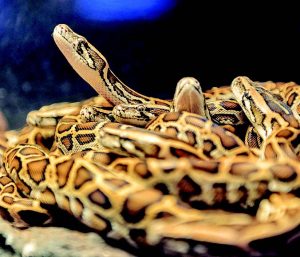It’s 3 pm and you’re hungry, so you head down to the kitchen to make a snack. You’re busy fumbling with the peanut butter jar when suddenly, out of the corner of your eye, you notice something darting across the floor. You turn around to see what it is, and it’s… a snake!
Your first instinct is to grab something to hit her with—but wait. Is it really necessary to harm the snake? She’s probably just as freaked out as you are, confused by the strange creature that’s shrieking and flailing in front of her.
Contrary to popular belief, snakes don’t just go around biting people for no reason. They will only bite an animal they don’t regard as prey in self-defense, and the majority of snakebites actually occur when people try to catch or kill a snake, according to a 2017 article in WhyDoSnakesBitePeople.com.

In fact, snakes are generally not aggressive and would rather avoid humans as much as possible, according to the National Council of SPCAs. Even a venomous rattlesnake would rather shake her tail than bite when provoked!
So what should you do if you discover a snake inside your home?
Snake-proofing your home
Prevent future snake encounters by making your property inaccessible and unattractive to these slinky reptiles. Check your house thoroughly for any openings such as cracks, holes, and gaps, and seal them right away.
If you have a garden, make sure you tend to it regularly. Overgrown lawns and piles of debris make for good hiding places for snakes, as recommended by Snake-Removal.com.
Slithery Facts
There are more than 180 snake species in the Philippines, and only 33 to 41 are venomous, according to Leviton and team.
Snakes are shy critters that will only bite in self-defense if they feel threatened. Ninety-seven percent of snakebites happen when people try to mess with snakes, according to Wildlife Removal USA.
Who You Gonna Call?
Metro Manila residents may contact the DENR-Biodiversity Management Bureau (BMB) at (02) 9246031 to 35, while those outside the metro may call their nearest DENR satellite office, as recommended by Jonathan Mayuga in a 2017 Business Mirror article.
Turning a Scaly Situation Around

Finding an uninvited, scaly guest in your house can be distressing, but it’s possible to get the snake out without harming her or yourself. For the safety of both human and reptile, take the following steps:
• Stay calm and avoid scaring the snake into hiding, as this will make it harder to remove her from your home.
• Keep children and pets away from the area.
• Open the nearest door and gently guide the snake out with a broom from a safe distance, according to Wildlife Removal USA.
• If you’re dealing with a small or coiled snake and it’s not possible to sweep her out, place a bucket or bin over her carefully, weigh it down, and poke air holes in the container, as advised by The Humane Society of the United States (HSUS). Call the Department of Environment and Natural Resources (DENR) for assistance with releasing her back into the wild.
• If the snake is in hiding, you can try luring her out by placing a heating pad or a pile of burlap or other fabric on the floor, as snakes like warm and dark places.
• If you aren’t scared of snakes and know for a fact that the one you’re dealing with isn’t venomous, you can put on some thick gloves, pick up the snake gently, and move her outside, according to the HSUS. You can also cover the snake with a large towel or blanket, scoop her into a pillowcase, then take her outside, according to Snake-Removal.com. Only do this if you’re sure neither you nor the snake will be harmed.
Why Save Snakes?
Is the only good snake a dead snake?
Not really. Snakes are misunderstood creatures that are often portrayed as the bad guys of the animal kingdom. According to a 2014 article by Grant Smith in CapeSnakeConservation.com, they actually do a lot of good for the ecosystem, such as keeping rodent populations in check. They even help prevent Lyme disease, since they prey on the small rodents that carry it, said Jason Bittel in a 2013 article published in Huffington Post.
The shed skin of snakes are useful, too! Snake skins contain nutrients that cycle through food webs and eventually make their way back to the earth, and some bird species use them in building their nests.
Snakes are harmless in most cases, and the majority of the species found in the Philippines are not dangerous to humans, according to Leviton and colleagues in The Coral Triangle: The 2011 Hearst Philippines Biodiversity Expedition. Venomous or not, all snakes play an important role in the ecosystem and deserve to be treated with care.
This appeared in Animal Scene magazine’s September 2018 issue.






